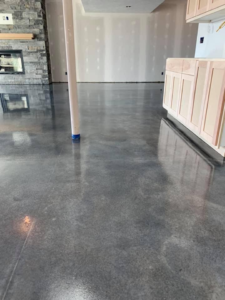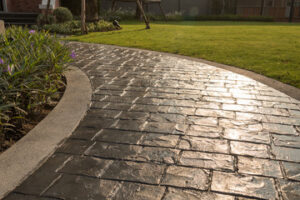Stains are used to tint or shade concrete surfaces. The stains can be either film-forming or penetrating.
Existing old concrete can be stained as long as the surface is not contaminated with glue, paint, oil, grease, wax, or any other substances that prevent the stain from soaking in. Contact Stained Concrete Dallas now!

The concrete surface should be acid-etched before staining. This helps the stain to bond with the concrete.
Variegated Colors
The concrete color options available for stained concrete are nearly limitless, with the ability to create marbled and variegated effects, layered colors and unique patterns. Skilled decorative contractors use topical stain products to produce colors and effects that mimic the look of natural stone, wood, slate and a variety of other natural materials, creating show-stopping concrete floors, patios, pool decks and walkways.
The key to a successful staining project lies in thorough surface preparation, including pressure washing and chemical cleaning. Once the concrete is cleaned, the chosen color is applied to the surface using spraying, brushing or rolling. The type of stain and its application method determine the final aesthetic of the finished product, with acid-based stains creating more variegated, marbled effects while water-based stains offer consistent coloration and a broader spectrum of hues.
Stains penetrate the concrete surface and react chemically with its natural elements, resulting in long-lasting color that won’t chip, peel or fade. Available in earth tones, stains impart rich, translucent color to indoor or outdoor concrete surfaces. Because stains penetrate the surface, imperfections and blemishes in the concrete often show through the color, but many see this as part of its charm.
In contrast, concrete paint coats the surface, resulting in a layer of color that can flake, chip and peel over time. If an opaque coloring solution is required, Brickform offers a cementitious coating called Cem-Coat that outperforms paint and can be used on new or existing concrete.
Like stains, concrete dyes are a topical color option for indoor or outdoor concrete. Made from super fine pigment particles that are suspended in a liquid carrier such as water or acetone, these colorants are typically applied to polished or tightly troweled concrete surfaces and can be sealed or coated like a stain. However, unlike stains, concrete dyes are not UV stable and will fade over time when exposed to direct sunlight.
Integral pigment is another permanent concrete coloring option that is mixed into the concrete during pouring, providing an even color throughout the slab. This method can be installed on new or old concrete and is ideal for applications such as patios, walkways and pool decks that would require a slippery sealer over a wet surface. While integral color increases the cost of a concrete pour, it reduces the installation time and can be an economical choice for projects where speed is of the essence.
Natural-Looking Colors
Concrete stain is a popular way to give new life to old or worn-out concrete surfaces, whether it’s an interior floor in a warehouse or a patio outside a restaurant. Since staining alters the color of a concrete surface without changing its physical strength, it is an eco-friendly renovation option that can save money versus replacing an existing floor or sidewalk. Stains can also create an appealing look that complements any design theme and help increase property value at a fraction of the cost of other decorative options like carpet, tile or wood.
Acid-based stains penetrate the concrete and react chemically with its pores, becoming a permanent part of the surface rather than simply coating it like paint. They typically produce earthy shades of tans, browns and terra cottas and are resistant to chipping and peeling.
Water-based stains have more color flexibility and are great for refreshing stained concrete that has faded. They’re available in a plethora of standard colors as well as some metallic tints. They can be used on both broom finish and smooth or stamped concrete. For a more realistic appearance, water-based stains can be applied to highlight areas of brick, stone and natural concrete to mimic the appearance of individual stones or tiles.
The color of stained concrete varies based on the type of concrete finish used, how porous the concrete is and how much stain is applied. Darker stains tend to last longer than light stains, but both will fade over time. Re-staining the concrete is an easy process that can restore faded color and keep it looking like new.
When stained concrete is properly prepared and sealed, it can provide a long-lasting, low-maintenance finish. This is because stains do not require the sanding and buffing that is necessary to maintain most other types of decorative concrete. This low-maintenance factor is one of the most significant benefits of using a concrete stain, especially for commercial or residential floors.
During the staining process, it’s important to follow proper safety protocols to avoid inhaling fumes and protect yourself from chemicals. Concrete stains and sealers have strong, hazardous chemical odors that can cause health problems if the work area is not ventilated adequately. Make sure to wear a mask and use fans to control airborne chemicals during the application process.
Durability
Stained concrete is a popular flooring choice that delivers beauty, durability, and value for homeowners. It holds up to heavy foot traffic, resists wear and tear, and can last for years with minimal maintenance. Stained concrete is also a cost-effective alternative to natural stone or tile and can increase the value of your home.
The staining process penetrates the concrete and reacts chemically with its lime content to produce permanent, fade-resistant color that won’t chip or peel away. Stains come in a variety of shades, from neutral earth tones to bold hues and can make your concrete look like wood, marble, or even leather. There are two types of stains, acid-based and water-based. Acid-based stains utilize hydrochloric acid and metallic salts to chemically react with the concrete’s minerals, creating unique color and marbling effects. Water-based stains use pigments to impart color to the concrete and are available in a wider range of hues.
Both acid-based and water-based stains are highly durable. However, they require proper cleaning and preparation to ensure the best results. Dirt and debris can interfere with the penetration of the stain, resulting in splotchy and uneven coloring. Before staining, sweep and scrub the concrete surface with a stiff brush and power washer. A thorough cleaning removes any grease, oil, or other contaminants that can prevent the stain from bonding with the concrete.
While staining is an effective way to transform shabby concrete, it won’t conceal cracks or other flaws in the slab. It’s important to choose a staining contractor with experience in both new construction and existing concrete staining. If your slab has extensive imperfections, you may need to opt for a different coloring option.
Other coloring options, such as integral color, epoxy coatings, and cementitious overlays, provide more durable results than stains. They also create more consistent coloration and are able to reproduce patterned or mottled effects. However, they don’t offer the same level of visual enhancement as a stained concrete floor.
When it comes to changing a stain’s color, darkening is easy, but lightening can be tricky. Most contractors will apply a series of diluted layers until the desired shade is achieved. If you’re not happy with the results, a tinted sealer can help restore the color and improve the durability of your concrete.
Easy Maintenance
Concrete stains are a great choice for commercial and industrial settings. This is due to their durability and resistance to fire, which is a must in environments where flammable materials are used. Stained concrete floors are also easy to clean and maintain, as they can be mopped with a pH-neutral cleaner and water. They can also be easily buffed to produce a high-gloss finish, which makes them ideal for places that are frequented by customers or workers in food and beverage industries.
Concrete staining is a process that uses chemical reactions to color the surface of porous concrete, which means it won’t chip or peel like paint. The color of the stain also won’t fade or wear off, making it a much more durable option for flooring than paint.
Staining concrete is a fairly simple DIY project that can be performed on outdoor and indoor concrete surfaces. However, it’s important to assess the workspace and ensure it has adequate ventilation before beginning a staining job. In addition, you should wear personal protective equipment such as a mask and work gloves to avoid breathing in any chemicals or dust during the process.
Once the concrete is stained, it’s important to protect the floor by applying a sealer. This will help prevent the stain from fading or wearing over time and will keep moisture and dirt out. You can use either an oil-based or water-based sealer. Oil-based stains require more maintenance, as they need to be reapplied every four months. Water-based stains are less toxic and don’t emit as many fumes, but they will need to be reapplied about twice as often as oil-based stains.
It’s also important to sweep and vacuum regularly to remove dirt from the surface of the concrete, which can cause it to dull and scratch. You should also place protective pads or felt under furniture legs to prevent scratches and dents on the surface of your concrete floors. Using these simple steps will keep your concrete looking its best and prolong its lifespan.
If you’re interested in updating your home with a new look, concrete staining is an affordable and effective solution. It can transform dull and outdated concrete into a beautiful and functional space. It’s an excellent option for patios, driveways, garage floors, pool decks and more.
